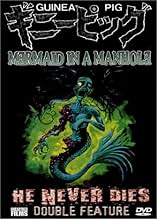Guinea Pig: Mermaid in the Manhole
Titre original : Ginî piggu: Manhôru no naka no ningyo
- Vidéo
- 1988
- 1h 3min
NOTE IMDb
5,5/10
2,7 k
MA NOTE
Ajouter une intrigue dans votre langueAn artist rescues a mermaid in a sewer, who develops bleeding sores all over her body. He paints a portrait with what oozes from her body, and eventually dismembers her.An artist rescues a mermaid in a sewer, who develops bleeding sores all over her body. He paints a portrait with what oozes from her body, and eventually dismembers her.An artist rescues a mermaid in a sewer, who develops bleeding sores all over her body. He paints a portrait with what oozes from her body, and eventually dismembers her.
Avis à la une
Mermaid in a Manhole is the fourth entry in the more than infamous Japanese Guinea Pig series which tries to be as shocking as a film can be. This kind of trash can be made only in Japan. Mermaid is directed by Hideshi Hino, a man behind the most infamous part of the series, Guinea Pig 2: Flowers of Flesh and Blood. Mermaid is not as sick as the first two entries in the series, but Mermaid is still very very disgusting and "shocking" as the young painter finds a wounded and beautiful mermaid from a sewer and takes her home and places into tub. He begins to paint her as she is unconscious in the tub, but soon she begins to have some very severe symptoms of "melting" as pus filled and exploding vesicles appear on her skin and soon she is FILLED with crawling worms and disgusting excretions and secretions as her slow death comes more and more near..So this doesn't make much sense and all the film has to offer are shocks and a need for barf bag.
The scenes of wet and pus spurting mayhem are disgusting enough, but what I really had difficulties to sit through were the scenes of thousands of slithery worms which are definitely real and plenty, and the girl has them in her mouth, too! What kind of an actress would agree to act in such a role? I'm not actually scared of worms or don't hate them, but there are so many hundreds of them and they are filled with blood and pus and they appear ANYWHERE from the girl's body and they are very lively and active so I simply couldn't watch the film without some disgust reactions, even though I watched the whole thing and didn't use any fast forward. So I definitely can recommend this, if you're looking for something very disgusting and despisable!
There are no cinematic merits in this film (or other Guinea Pig films), although the scene in the sewer is pretty haunting, so that is perhaps the only cinematic merit of the film! Either horror fans like these or then not. Others will puke trying to watch these, that's for sure! Try to show Mermaid to your girlfriend or sister and count seconds how much she can take! It is impossible to give stars for these films, because there are nothing but scenes of disgust and loathing. If you're a fan of Japanese extreme horror and sicko cinema, then Guinea Pigs are worth tracking down as a curiosity, but they are by no means great or noteworthy films, no matter how hard core horror fan one thinks he is. I watched this film (and most of the whole series) as a curiosity and 'cause I'm interested in Orient cinema in its all forms, excluding s/m cinema and other of its kind. As a marginal cinema fanatic, I give Mermaid 5 stars out of ten even though it is pretty useless to give stars for these. At least this is the most disgusting film I've ever seen!
The scenes of wet and pus spurting mayhem are disgusting enough, but what I really had difficulties to sit through were the scenes of thousands of slithery worms which are definitely real and plenty, and the girl has them in her mouth, too! What kind of an actress would agree to act in such a role? I'm not actually scared of worms or don't hate them, but there are so many hundreds of them and they are filled with blood and pus and they appear ANYWHERE from the girl's body and they are very lively and active so I simply couldn't watch the film without some disgust reactions, even though I watched the whole thing and didn't use any fast forward. So I definitely can recommend this, if you're looking for something very disgusting and despisable!
There are no cinematic merits in this film (or other Guinea Pig films), although the scene in the sewer is pretty haunting, so that is perhaps the only cinematic merit of the film! Either horror fans like these or then not. Others will puke trying to watch these, that's for sure! Try to show Mermaid to your girlfriend or sister and count seconds how much she can take! It is impossible to give stars for these films, because there are nothing but scenes of disgust and loathing. If you're a fan of Japanese extreme horror and sicko cinema, then Guinea Pigs are worth tracking down as a curiosity, but they are by no means great or noteworthy films, no matter how hard core horror fan one thinks he is. I watched this film (and most of the whole series) as a curiosity and 'cause I'm interested in Orient cinema in its all forms, excluding s/m cinema and other of its kind. As a marginal cinema fanatic, I give Mermaid 5 stars out of ten even though it is pretty useless to give stars for these. At least this is the most disgusting film I've ever seen!
Guinea Pig III: Mermaid in a Sewer (Hideshi Hino, 1988)
Mermaid in a Sewer, one of the four Guinea Pig films directed by Hino, is the only one that rivals The Flower of Flesh and Blood in notoriety and popularity. Unlike its more graphic and brutal cousin, Mermaid in a Sewer (often translated as Mermaid in a Manhole, Mermaid in the Bathtub, or any other number of similar titles) actually has a plot to it. An artist (Shigeru Saiki), obviously modeled on Hino himself (Hino's style is unmistakable), draws his inspiration from things he sees and finds in his local sewer system. One day, what he finds among the muck and stench is... a mermaid (Mari Somei). Yes, a mermaid. A very attractive one at that (and one is forced to wonder what, exactly, would motivate an actress to play a part like this...). We find out, after the two have conversed a bit and he's done a preliminary sketch, that she is wounded. He takes her home (how he gets her there without anyone noticing is beyond me) and installs her in his bathtub in order to take care of her.
You can see where this is going, I'm sure. Wound + sewer = bad, bad things.
I'd comment on the acting, dialogue, etc. if I actually understood Japanese. Sometimes watching films in foreign languages with no subtitles is good for the soul, I guess (though anyone who happens to have a script from either 2 or 3 in English who'd be willing to send a copy my way would be remembered in my will, and not with a debt). The couple who lives downstairs from the artist (Masami Hisamoto, Tsuyoshi Toshishige) pop up every now and then to give what would seem a comic turn to the film, which only adds to the disgust and horror. If you get nightmares easily, this is not a film you ever want to see. As Joaquin Phoenix said in what was one of only a handful of lines in _8mm_ that's actually worth remembering, "there are some things you can't un-see." I could never pop this tape into the cassette player again, and certain images would remain as fresh in my mind as they are right now. It's that bad. *** 1/2
Mermaid in a Sewer, one of the four Guinea Pig films directed by Hino, is the only one that rivals The Flower of Flesh and Blood in notoriety and popularity. Unlike its more graphic and brutal cousin, Mermaid in a Sewer (often translated as Mermaid in a Manhole, Mermaid in the Bathtub, or any other number of similar titles) actually has a plot to it. An artist (Shigeru Saiki), obviously modeled on Hino himself (Hino's style is unmistakable), draws his inspiration from things he sees and finds in his local sewer system. One day, what he finds among the muck and stench is... a mermaid (Mari Somei). Yes, a mermaid. A very attractive one at that (and one is forced to wonder what, exactly, would motivate an actress to play a part like this...). We find out, after the two have conversed a bit and he's done a preliminary sketch, that she is wounded. He takes her home (how he gets her there without anyone noticing is beyond me) and installs her in his bathtub in order to take care of her.
You can see where this is going, I'm sure. Wound + sewer = bad, bad things.
I'd comment on the acting, dialogue, etc. if I actually understood Japanese. Sometimes watching films in foreign languages with no subtitles is good for the soul, I guess (though anyone who happens to have a script from either 2 or 3 in English who'd be willing to send a copy my way would be remembered in my will, and not with a debt). The couple who lives downstairs from the artist (Masami Hisamoto, Tsuyoshi Toshishige) pop up every now and then to give what would seem a comic turn to the film, which only adds to the disgust and horror. If you get nightmares easily, this is not a film you ever want to see. As Joaquin Phoenix said in what was one of only a handful of lines in _8mm_ that's actually worth remembering, "there are some things you can't un-see." I could never pop this tape into the cassette player again, and certain images would remain as fresh in my mind as they are right now. It's that bad. *** 1/2
A painter named Hayashi(Shigeru Saiki)finds a wounded mermaid(Mari Somei)and saves her.He takes her home and puts her into his bathtub where she keeps decomposing,the spreading disease spurting blood and pus.Hideshi Hino's "Guinea Pig 4:Mermaid in the Manhole" is easily one of the most disgusting horror movies I have ever seen.The make-up effects made by Nobuaki Koga are incredibly revolting.The character of Hayashi is pretty sympathetic and the film has a mood of a very sad romance.The mermaid represents painter's wife and "all the beautiful things" he has lost,so she is bound to rot and vanish too."Mermaid in the Manhole" works as a piece of extreme art,so anyone who loves Japanese horror should give it a look.However if you're easily offended avoid this one like the plague.
I saw this in the middle of the night, and it wasn't subtitled. Still, I figured out what it was about, despite the fact that I don't speak it's language. It's about what appears to be a painter who rescues an injured woman who begins to rot and spew pus. As she dies, he uses her goop as paint. The film's ending is depressing as it appears that he wasn't playing with a full deck.
The overall tone of the film is bad enough without the bizarre situation, but the fact that the film literally doesn't race makes the outcome more of an effective idea that could be better implemented with a little less patience. Still, when the screen isn't drenched with guts and pus, it's pretty to look at. This is, i guess, a part of some strange series of films in Japan that deal with special effects gore and realism. This works in both areas, but also happens to have a little more to offer.
The overall tone of the film is bad enough without the bizarre situation, but the fact that the film literally doesn't race makes the outcome more of an effective idea that could be better implemented with a little less patience. Still, when the screen isn't drenched with guts and pus, it's pretty to look at. This is, i guess, a part of some strange series of films in Japan that deal with special effects gore and realism. This works in both areas, but also happens to have a little more to offer.
8w00f
Wow.
I have rarely seen a film that manages to be intensely disgusting and poetically beautiful at the same time. Despite the reputation of the Ginipiggu films, this wasn't the most intense gore I've ever seen... Fulci's "Paura nella città dei morti viventi" is more disturbing, if not more graphic, and certainly far more violent. Fulci's film doesn't come close to the visual poetry that "Mermaid" exhibits in places, nor does it delve into the places in the soul that this film did.
Confused yet?
The basic story of "Mermaid": a Japanese artist has a penchant for lurking in a sewer near his home. We find out that this is because a beautiful mermaid lived in the river that once flowed where the sewer now sits. While skulking in the sewer one day, he finds the mermaid. She's been living in the darkness for decades, having become stranded when the city was built. The painter visits her repeatedly, and one day notices a horrible infection beginning on her abdomen. He realizes that she's gotten this infection from being trapped in the sewer for so long, and so he takes her home to care for her and paint her.
The mermaid is the embodiment of the painter's childhood dreams, his innocence, and his joy. The infection is the decay of his own being, his psyche itself. As the film progresses, so does the infection, slowly disfiguring the mermaid until she comes to resemble ground beef covered with tumors that ooze multi-colored pus and occasionally give rise to masses of worms. She won't die, though, until he finishes his painting of her. She does die (which is an obvious outcome from the early part of the film -- but not the *ending*), and she does so slowly, painfully, horribly, and very graphically. If the thought of a boil-covered, bleeding woman lying in a bathtub filled with her own blood (and other fluids) while vomiting up blood and worms seems unpalatable to you, do NOT watch this film. I could easily see some of the scenes inducing a reversal of peristalsis in many viewers. I've seen some intense horror flicks and some very "realistic" gore, but there were definitely some nauseating and difficult moments for me in "Mermaid".
There's also a scene wherein the mermaid has died and we see flowing paint obscure the paintings that the artist has rendered from his childhood memories as he dismembers her body, ostensibly for disposal. If I told any more, though, I'd be giving away the ending... and that wouldn't be fair.
If you've got the stomach for it, I would highly recommend this film. The acting is solid (the dialogue is in Japanese with English subtitles), and the production values are quite good for a straight-to-video effort. This was a top ten seller in Japan for two months when it first came out, and with good reason. In many ways, this is a really excellent film, and it balances loathing and almost Poe-like horror with a certain inner beauty. I'm not generally a big fan of Japanese horror, but I haven't seen anything else that manages such a fine balancing act.
"Mermaid in a Manhole" is available in the US only through Unearthed Films. It's worth the effort and expense to get hold of a copy.
I have rarely seen a film that manages to be intensely disgusting and poetically beautiful at the same time. Despite the reputation of the Ginipiggu films, this wasn't the most intense gore I've ever seen... Fulci's "Paura nella città dei morti viventi" is more disturbing, if not more graphic, and certainly far more violent. Fulci's film doesn't come close to the visual poetry that "Mermaid" exhibits in places, nor does it delve into the places in the soul that this film did.
Confused yet?
The basic story of "Mermaid": a Japanese artist has a penchant for lurking in a sewer near his home. We find out that this is because a beautiful mermaid lived in the river that once flowed where the sewer now sits. While skulking in the sewer one day, he finds the mermaid. She's been living in the darkness for decades, having become stranded when the city was built. The painter visits her repeatedly, and one day notices a horrible infection beginning on her abdomen. He realizes that she's gotten this infection from being trapped in the sewer for so long, and so he takes her home to care for her and paint her.
The mermaid is the embodiment of the painter's childhood dreams, his innocence, and his joy. The infection is the decay of his own being, his psyche itself. As the film progresses, so does the infection, slowly disfiguring the mermaid until she comes to resemble ground beef covered with tumors that ooze multi-colored pus and occasionally give rise to masses of worms. She won't die, though, until he finishes his painting of her. She does die (which is an obvious outcome from the early part of the film -- but not the *ending*), and she does so slowly, painfully, horribly, and very graphically. If the thought of a boil-covered, bleeding woman lying in a bathtub filled with her own blood (and other fluids) while vomiting up blood and worms seems unpalatable to you, do NOT watch this film. I could easily see some of the scenes inducing a reversal of peristalsis in many viewers. I've seen some intense horror flicks and some very "realistic" gore, but there were definitely some nauseating and difficult moments for me in "Mermaid".
There's also a scene wherein the mermaid has died and we see flowing paint obscure the paintings that the artist has rendered from his childhood memories as he dismembers her body, ostensibly for disposal. If I told any more, though, I'd be giving away the ending... and that wouldn't be fair.
If you've got the stomach for it, I would highly recommend this film. The acting is solid (the dialogue is in Japanese with English subtitles), and the production values are quite good for a straight-to-video effort. This was a top ten seller in Japan for two months when it first came out, and with good reason. In many ways, this is a really excellent film, and it balances loathing and almost Poe-like horror with a certain inner beauty. I'm not generally a big fan of Japanese horror, but I haven't seen anything else that manages such a fine balancing act.
"Mermaid in a Manhole" is available in the US only through Unearthed Films. It's worth the effort and expense to get hold of a copy.
Le saviez-vous
- AnecdotesThis is the last film starring Mari Somei, as the 25-years-old actress mysteriously disappeared in 1988. Her fate remains unknown.
- Crédits fousAt the end of the credits there is a small scene in the sewer where we hear something move in the water.
- ConnexionsEdited into Guinea Pig's Greatest Cuts (2005)
Meilleurs choix
Connectez-vous pour évaluer et suivre la liste de favoris afin de recevoir des recommandations personnalisées
Détails
- Date de sortie
- Pays d’origine
- Langue
- Aussi connu sous le nom de
- Guinea Pig 5: Mermaid in a Manhole
- Sociétés de production
- Voir plus de crédits d'entreprise sur IMDbPro
- Durée
- 1h 3min(63 min)
- Couleur
Contribuer à cette page
Suggérer une modification ou ajouter du contenu manquant




















